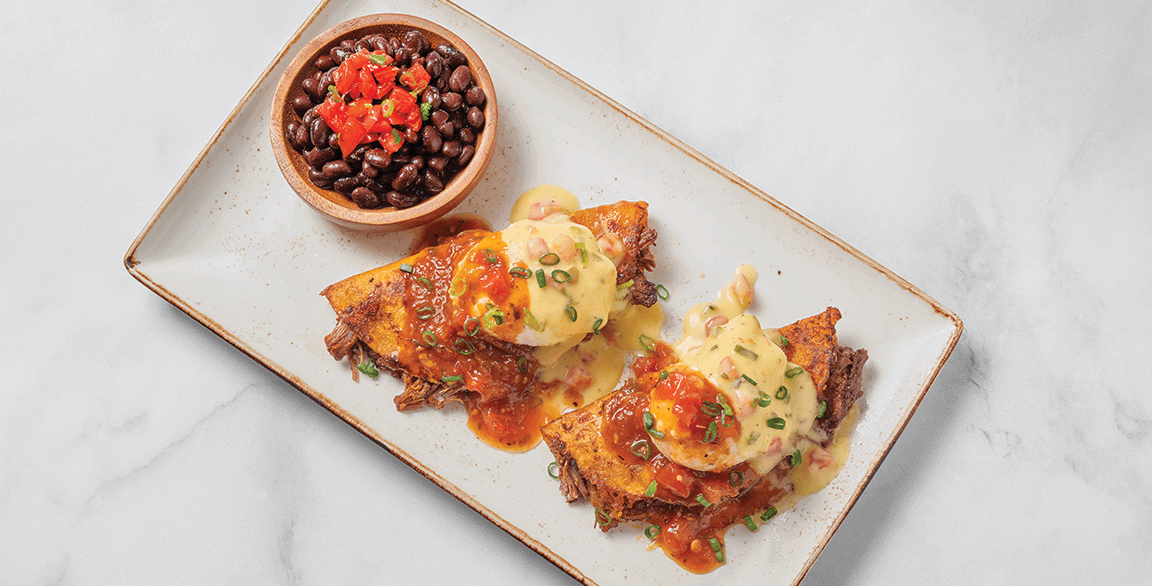
Much industry analysis centers on how the pandemic has changed…everything. Data is fantastic for understanding the big picture, but there’s a better way to gain a more illuminating view. We recently caught up with a handful of leading chefs in high-volume foodservice who we interviewed in June 2020. Two years have gone by since those early days of pivoting, regrouping, MacGyvering and strategizing on how not only to survive the short term, but thrive in the long term. Their ingenuity, innovation and passion for foodservice all endured despite COVID.
But what has changed? Has off-premise dining proven as key to ongoing success as they predicted it would? Do their guests still yearn for menus that promise comfort? What pandemic-born flavor strategies survived? What has shifted for their brands completely? Although each of the five chefs interviewed brings varying perspectives on these topics, a few themes weave through and offer important insights about today’s consumer mindset: perceived value is critical, trial and error from the last few years has helped crystallize how to target Gen Z, and savvy, customizable pricing strategies are driving modern guests to build higher per person averages (PPAs).
FIRST WATCH
Before the pandemic hit, First Watch, headquartered in Bradenton, Fla., was testing a third-party delivery partnership in four markets, with plans of a six-month rollout. The changes in market brought on by the pandemic accelerated the brand’s strategy with lightning speed and by June of 2020, digital ordering was in place systemwide. “Today, off-premise is bigger than our wildest projections could have anticipated,” says Shane Schaibly, SVP of culinary strategy and corporate chef of First Watch Restaurants. “We’re doing way more than double our initial goals now—our off-premise is at about 20 percent. Our business has shifted, and we’re embracing the entire platform.”
Like most strategies that were either born during COVID or accelerated because of it, First Watch’s off-premise business was fast-tracked out of necessity. “It was an accommodation. Off-premise wasn’t in the top five areas of focus for us,” Schaibly says. “And, now, it is very much in the top three. We have fully embraced it. Our customers have embraced it. It’s brought us a whole new demographic.”
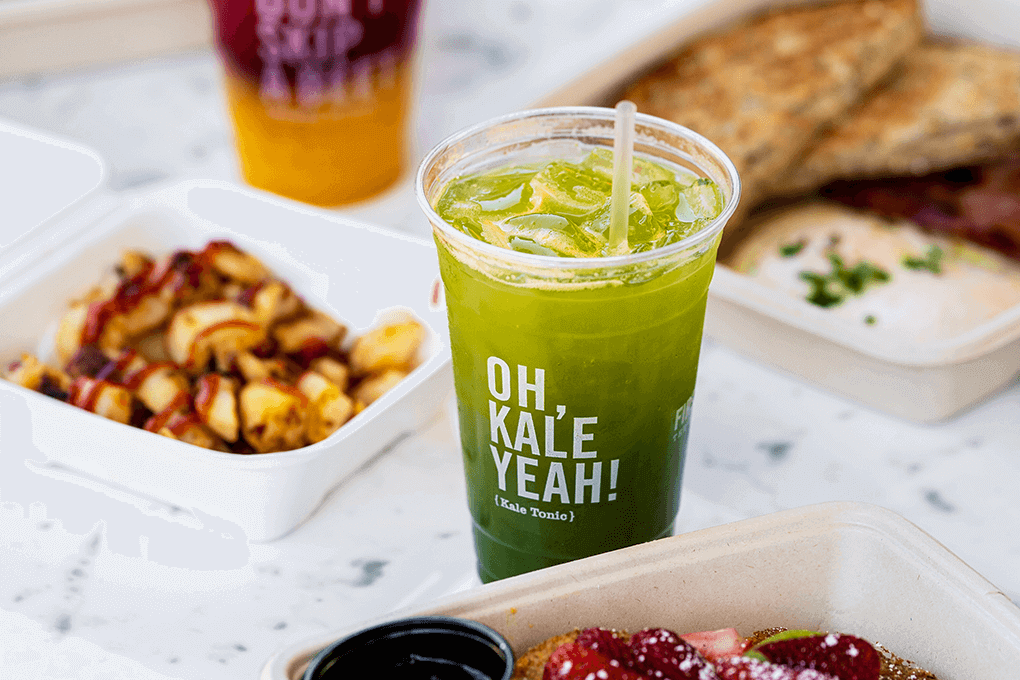 Credit: First Watch Restaurant Group
Credit: First Watch Restaurant Group The juices at First Watch have enjoyed huge success on social media, with younger consumers responding to their vibrancy, flavor and fun. The Kale Tonic with kale, Fuji apple, cucumber and lemon, sports a playful saying on its to-go cup, which the brand says is helping drive engagement.
Modern beverages have become the arm candy of the younger generation. We saw that and leaned into it, getting into social, which is where Gen Z lives.
Shane Schaibly, SVP Culinary Strategy/Corporate Chef, First Watch Restaurant Group
First Watch’s fresh juice program plays a significant role in its off-premise success. A savvy combination of trending flavors, eye-popping colors and sound marketing has transformed its drinks into social media stars. “Our guests are posting pictures and effectively advertising our Purple Haze beverage for us at the beach, on a bike ride, on a hike…. It’s interesting—modern beverages have become the arm candy of the younger generation. We saw this phenomenon and leaned into it, getting into social, which is where Gen Z lives,” Schaibly says.
Off-premise sales have also helped build its PPA through a strategy that First Watch calls “guest-selected pricing.” “Guests are going to build their check how they want, and if they don’t want to go above a certain amount, they’re not going to. But we have plenty of offerings to allow them to build that check as high as they want,” he says. “One of the biggest pieces of news for us in off-premise is that our PPAs almost always go up because we can dangle upgrades and add-ons in front of them, like a side of our Million Dollar Bacon or a Kale Tonic.”
BLOOMIN’ BRANDS
In 2020, Fleming’s Prime Steakhouse & Wine Bar unearthed a new demographic through its COVID-prompted takeout/delivery program. Younger consumers were ordering the fine-dining fare to go, then curating their experiences in parks, backyards and their own living rooms. “That was definitely a function of the times,” says Efrem Cutler, VP of R&D and corporate executive chef of Tampa, Fla.-based Bloomin’ Brands, the parent restaurant group of Fleming’s, along with Outback Steakhouse, Carrabba’s Italian Grill, Bonefish Grill and Aussie Grill by Outback. Today, however, customers are back, in force, for in-person dining. “Guests want to enjoy a restaurant experience—and indulge maybe more than they did pre-COVID with a mindset of ‘We’ve been through so much, we’re going to enjoy life,’” he says. “They’re celebrating more, spending more—our PPA is higher.”
But are the younger consumers who discovered Fleming’s through off-premise now coming into the restaurant? “Do I think we’ve captured those younger guests via the vehicle of delivery two years ago? Yes, I do. I think that we’ve broadened our market share, not only for Fleming’s, but all of our brands, because ordering online brings exposure to restaurant menus that perhaps they may not have tried in the past,” says Cutler. “Now, they want to interact with our brand differently. They want that entire restaurant experience.”
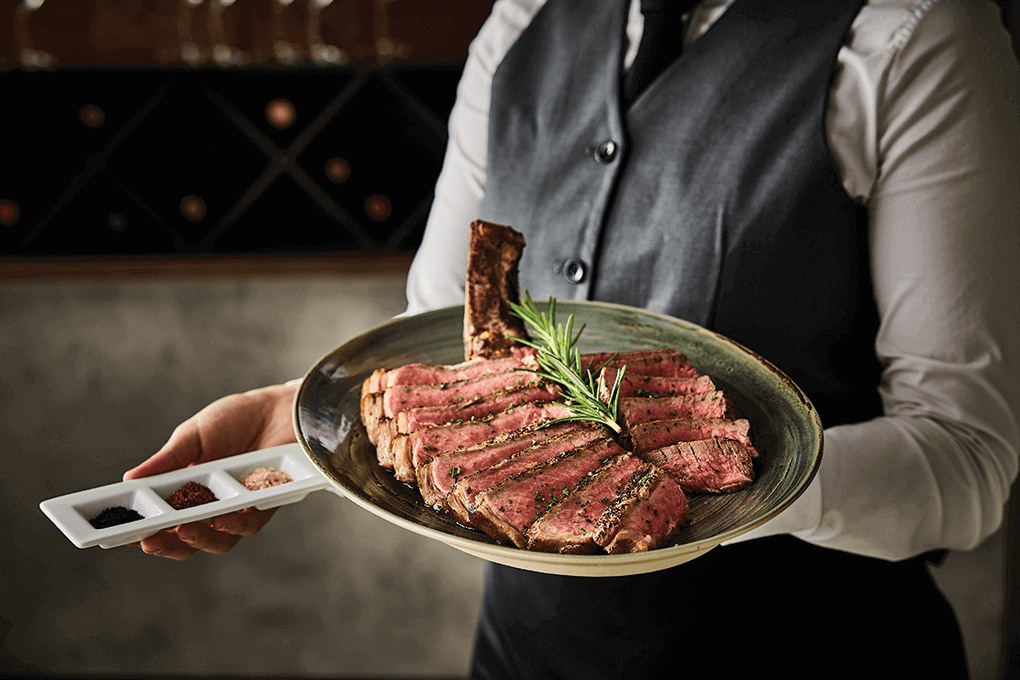 Credit: Dave Spataro
Credit: Dave Spataro Fleming’s Prime Steakhouse & Wine Bar is highlighting experiential dining with showstoppers like its Chef’s Reserve, one of the options in its “A Taste for Twosday” promotion. Here, a 28-oz. prime bone-in New York strip is paired with a 6-oz. filet mignon, sliced and served with a trio of artisan finishing salts: Himalayan pink, black lava and Merlot. A sprig of rosemary is torched by the server, adding a woodsy aroma and a theatrical touch.
That restaurant experience includes the type of sensory stimulation that the hospitality industry banks on. Fleming’s new premium shareable steak experience is the “Chef’s Reserve,” part of its “A Taste for Twosday” three-course dinner for two series. It features filet mignon and bone-in New York strip, accompanied by a trio of flavored salts. “We serve it with fresh rosemary that we torch so that when the server brings it out, you get that aroma and smoke of the herb,” says Cutler.
The drive to appeal to Gen Z and younger Millennials is strong at Fleming’s. “We’re working on a new bar menu now that will be compelling and craveable and you can only find here,” says Cutler. He describes the cuisine as “California Unexpected,” where the bounty of the state’s produce, dairy, meats and more will be featured. “There’s so much that we source from California that we don’t talk about, but we’re going to start to accentuate who we are,” he says. “We’re a fine-dining steakhouse, but we want to put our own twist on it with plant-forward offerings and flavors that you can’t find anywhere else.”
The interesting piece about the fast-casual arena is if you don’t have that barbell approach with inexpensive, familiar food—say, under $5 and up to $10 PPA—you’re not going to attract a large net of consumers. We’re now pumping in some value at Aussie Grill.
Efrem Cutler, VP of R&D/Corporate Executive Chef, Bloomin’ Brands
In the fast-casual arena, Cutler says the push to add drive-thru lanes to Aussie Grill in 2020 has paid off. “Fifty percent of our food goes out that window, and then another 20 percent goes through third-party delivery,” he says. “People are definitely using this brand as a convenience, and the drive-thru is an incredible component of that. I think it’s the right avenue to travel down, but we are still in the testing stage of a young brand. We should test stores that perhaps don’t have a drive-thru or don’t have dine-in—or maybe some kind of hybrid where there’s outdoor seating. We’re still figuring out exactly what the guest expectation is for Aussie Grill. We do know that customers love the food.”
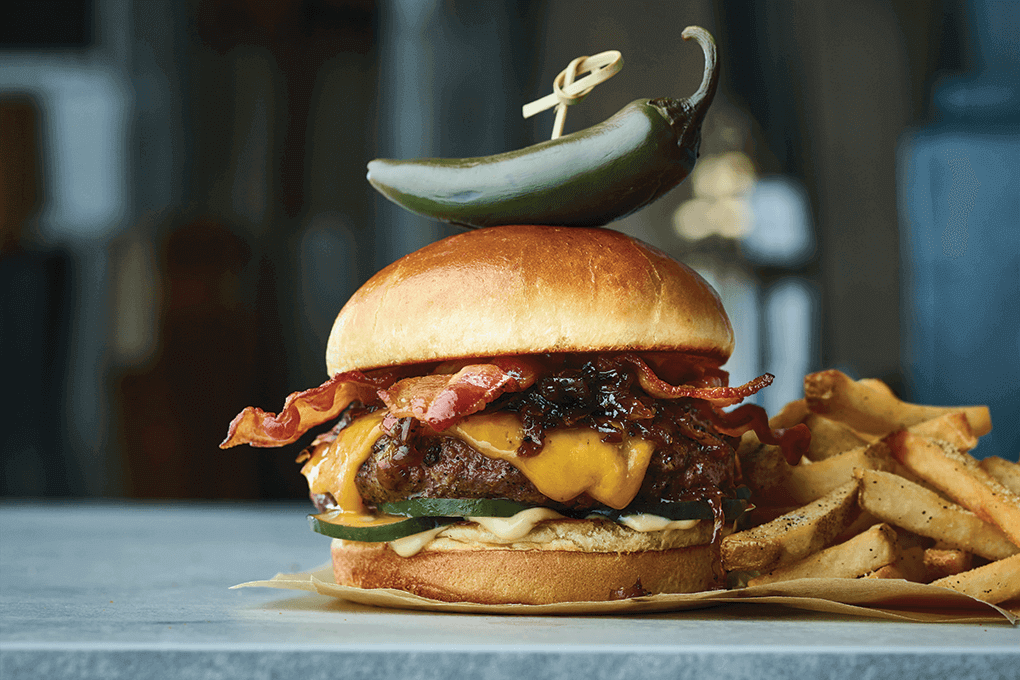 Credit: Dave Spataro
Credit: Dave Spataro Aussie Grill does a robust off-premise business, mostly through its drive-thru, proving that the fast casual’s investment here was a sound one. Guests can order items like this indulgent Bacon Bomb Burger, a beef patty topped with bacon-onion jam, crispy bacon, cheddar, housemade pickles, smoky mayo and a pickled jalapeño.
Cutler also knows the value of value. “The interesting piece about the fast-casual arena is if you don’t have that barbell approach with inexpensive, familiar food—say, under $5 and up to $10 PPA—you’re not going to attract a large net of consumers,” he says. “We’re now pumping in some value at Aussie Grill.” With “Tender Lovin’ Combos” (TLC), guests can choose up to five chicken tenders, running up the tab a little bit at a time. “The guests love the food, but they don’t come as frequently as we might like because the menu has a higher PPA, as well as indulgence factor. So I’m pumping in value, as well as more healthy options,” says Cutler. Aussie Grill recently rolled out its Cranberry Arugula Salad, with fresh arugula, dried cranberries, cucumber, toasted pumpkin seeds and shredded carrots, and a choice of ranch, honey mustard or balsamic vinaigrette.
VILLAGE TAVERN
Before the pandemic, Village Tavern, a neighborhood restaurant concept based in Winston-Salem, N.C., had a robust to-go business but had not yet launched itself into the delivery world. Mary Grace Viado Howard, corporate executive chef, was moving cautiously in that direction, wanting to ensure a high level of quality and personal customer connection. After COVID hit, however, plans accelerated, but her commitment to a premium guest experience didn’t falter. Now, 20 percent of Village Tavern’s business is made up of off-premise sales. “Before COVID, we were at maybe five percent. The challenge now is finding the balance because we’re at full capacity, and our first priority is our dining customers,” says Viado Howard.
Our focus over the last two years has been on reinforcing our unique company culture to attract talent and keep our valuable players. We want to celebrate the people who work within our four walls, take care of them and make sure it’s a vibrant environment.
Mary Grace Viado Howard, Corporate Executive Chef, Village Tavern
To help ease the operational strain at its busiest location, the restaurant has transformed a formerly little-used back kitchen into another full kitchen now dedicated to off-premise prep. “We’re able to pretty much keep it separate from main dining,” she says. For quality checks, Viado Howard places her own Village Tavern orders via DoorDash. “I want that user experience to make sure the packaging is correct, that we’re preserving the quality in delivery, and that safety standards are still being met,” she explains. Delivery can get so busy that Village Tavern sometimes has to temporarily turn off the DoorDash option so as not to overwhelm the kitchen. “The quality of what we put out is a priority. Equally important is the well-being of our employees,” says Viado Howard.
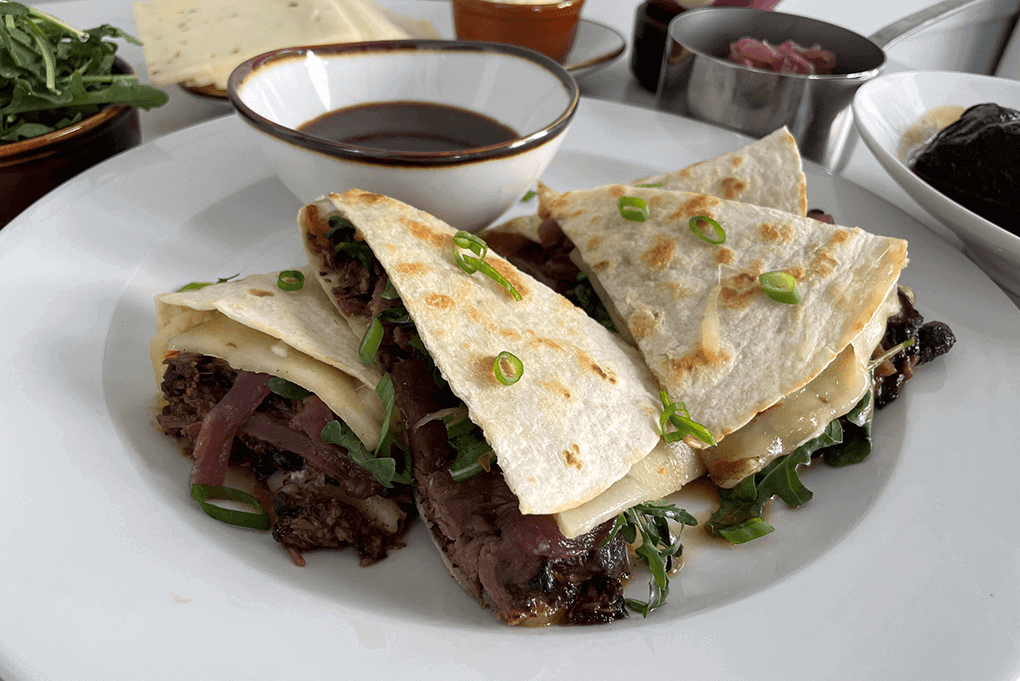 Credit: Mary Grace Viado Howard
Credit: Mary Grace Viado Howard Village Tavern struck gold with its new Braised Short Rib Quesadilla, which is outselling the concept’s classic short rib entrée. The quesadilla features three-day-braised short rib, Monterey Jack, caramelized and pickled onion, mayo and arugula.
That commitment to staff is an imperative for the brand and a core value for Viado Howard. “Like everybody else in our industry, we’ve experienced staff shortages that we’ve never seen before. Our focus over the last two years has been on reinforcing our unique company culture to attract talent and keep our valuable players. We want to celebrate the people who work within our four walls, take care of them and make sure ours is a vibrant environment.”
In June 2020, Village Tavern was “approaching innovation a little more cautiously than before.” Today, Viado Howard talks about “elevated comfort food,” with creative successes like a recent limited rollout of a Braised Short Rib Quesadilla, featuring three-day-braised chunks of Angus beef, Monterey Jack cheese, mayonnaise, pickled and caramelized onion and baby arugula. “It’s doing better than our short rib entrée!” she says.
TWIN PEAKS
Twin Peaks, based in Dallas, was closed to all foot traffic throughout the 2020 shutdown, Alex Sadowsky, director of culinary, beverage and menu innovation, says he was never busier. He and his team used that time to lay out a roadmap to future success, tightening the menu, gearing up for a surge in off-premise business and taking the long view for flavor innovation.
“Today, we’re so far up in business in general that the focus needs to be on operations rather than on to-go,” he says. “Back then, I was guessing that off-premise was here to stay. I have some theories as to why it didn’t stick for our brand or for a lot of other restaurant brands: It’s just very expensive. And then we started hitting supply chain problems with to-go packaging and everything that goes along with it. So in my opinion, that whole takeout opportunity got torpedoed part of the way through COVID for a lot of us in the industry.”
Our reading of the tea leaves is that a number of consumers are trading down from high-end restaurants into concepts like Twin Peaks because of the value perception. We’re going to test the waters a little bit with menu items like our hand-cut steaks.
Alex Sadowsky, Director of Culinary, Beverage and Menu Innovation, Twin Peaks
Sadowsky still sees value in to-go operations and puts thought into its continued execution at Twin Peaks. “We think about how the item is going to travel, if we need to tweak any components—salt, sweet, sour and so on—but our R&D doesn’t start with to-go in mind,” he explains. But he doesn’t pull his punches when it comes to his views on the off-premise arena in general. “I think the overall experience sucks on both the operator side and for the guest experience. There’s not a lot of positives to it. I don’t know how the third-party people keep pushing its expansion. There are so many restaurant brands like ours that are extremely busy with same-store sales. We thought we were going to have this excess capacity in the kitchens to do ghost kitchens and third-party stuff, but I’m just trying to get enough cooks and food to keep things going for the regular restaurant. We didn’t foresee that coming at the beginning of COVID,” he says.
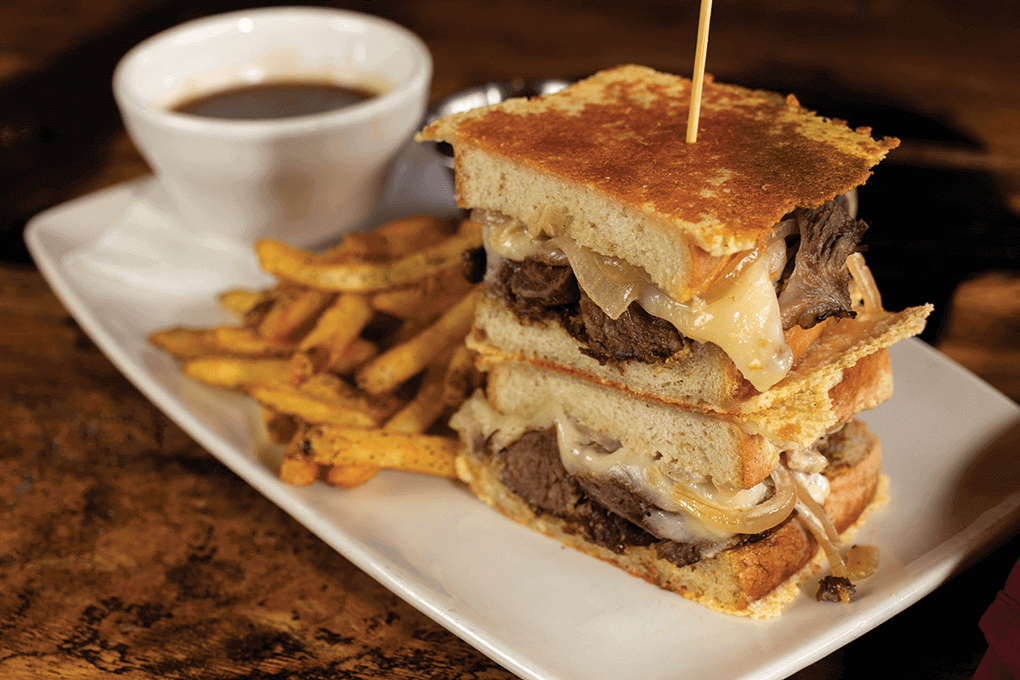 Credit: Twin Peaks
Credit: Twin Peaks Twin Peaks finds the sweet spot between comfort classic and singular experience with menu items like this Parmesan-Crusted Pot Roast Grilled Cheese with slow-cooked pot roast, Swiss, provolone, Parmesan, caramelized onions, horseradish aïoli and Creole mustard. It’s served on grilled sourdough with a side of Knotty Brunette au jus and seasoned french fries.
What Sadowsky did successfully bet on is that Twin Peaks’ guests would crave new flavor combinations and exciting menu options. “We’re branching way out into flavor adventure again while still balancing the menu with comfort-food options,” he says. The chain has plans to launch housemade flatbreads, currently in the R&D phase, at all locations. The list of possible flavor profiles is playful, creative and bold and includes: tikka sauce, Monte Cristo, truffle-mascarpone, chicken and waffles, lobster roll and “Humboldt Fog on everything.” “It’s one of those categories where people are like, ‘Throw it at me! I’m willing to try it in this vehicle,’” says Sadowsky.
When it comes to comfort food, Twin Peaks is leaning toward a premium positioning for some of its offerings. “We’ve seen much more traffic in first-time guests that have a very high check average,” he says. “Our reading of the tea leaves is that a number of consumers are trading down from high-end restaurants into concepts like Twin Peaks because of the value perception. We’re going to test the waters with menu items like our hand-cut steaks; but we’ll keep it grounded with comfort-centric garlic mashed potatoes.” He’s seeing consumers “trade up” to Twin Peaks, as well. “We’re trying to watch and understand who we share the market with today—it’s definitely shifting, and we need to move with it,” says Sadowsky. “We want our menu to attract those diners, too.”
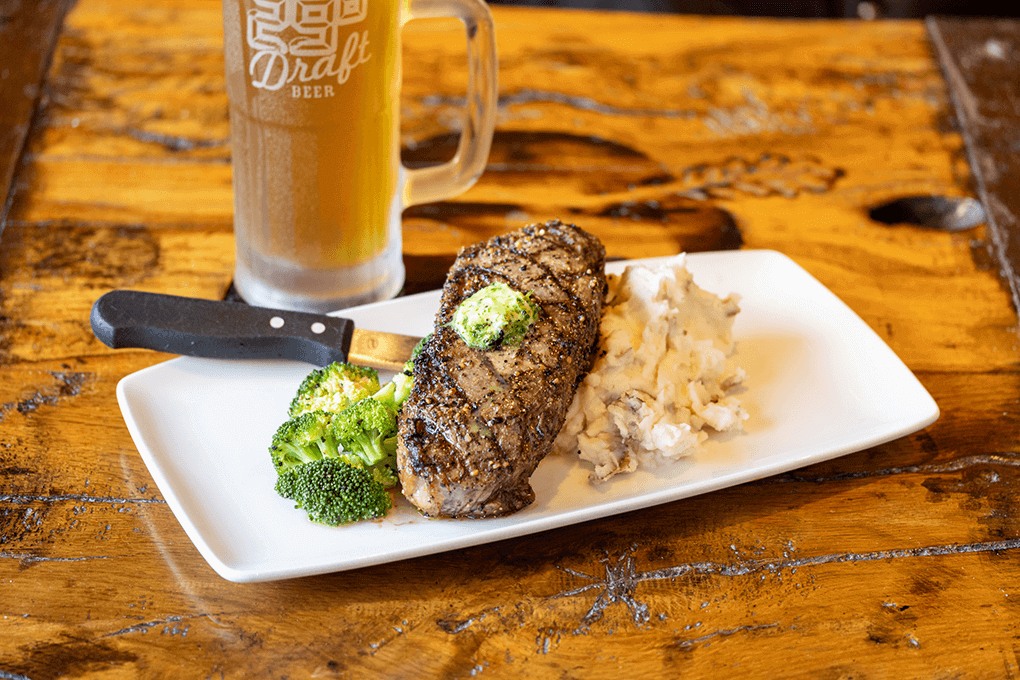 Credit: Twin Peaks
Credit: Twin Peaks With more traffic from first-time guests who are running higher check averages, Twin Peaks is making sure the menu speaks to them with new premium items, like hand-cut steaks. This Hand-Cut NY Strip is topped with garlic-parsley butter and served with garlic mashed potatoes and sautéed broccoli, or a choice of two sides.
CREATIVE DINING SERVICES
When we spoke with Ian Ramirez, director of culinary innovation with Creative Dining Services, a hospitality and dining services provider based in Zeeland, Mich., back in June 2020, he was throwing up a flare, asking for supplier support to alleviate serious staffing issues brought on by strict COVID protocols and a reduced labor pool. “We needed speed-scratch items to lessen the burden on the kitchen and keep up with the demand of the high volume that we do in noncommercial food prep,” he says.
With supply chain issues continuing to disrupt menu planning and prep, Ramirez has had to pivot again. “The technology platforms that we use for our menus and recipes are really intuitive but very complex with a lot of data behind them. You have all of your ingredient statements, nutritional information, allergens—all of that data is pre-programmed,” he explains. But if the spec on a chicken tender changes because of supply issues, and the substitute product has a new food allergen in it, the ingredient statement in the system must be updated.
We’re moving back to adventure, mixed with a healthy dose of functional foods. The big themes for us this past year and moving forward are about self-care: taking care of our mental health and taking care of our bodies.
Ian Ramirez, Director of Culinary Innovation, Creative Dining Services
“So this week you get this product on the truck, and the next week you get that one, and each time there are different ingredients. It’s like playing Whac-a-Mole and has created a lot of complexity,” he says. So he and his team took a step back from speed-scratch and assessed what they could go back to making wholly from scratch. With COVID restrictions lifted, Ramirez finds that labor issues are more manageable for this approach. “We’ve been navigating labor pretty well,” he says. “We still have challenges, but we have a lot of talent, and we’re really good at retaining that talent.”
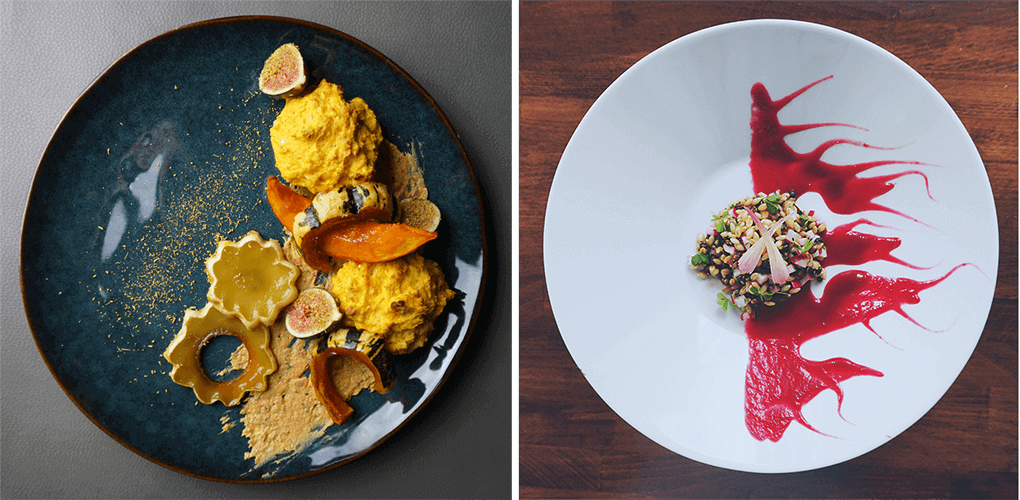 Credit: Creative Dining Services
Credit: Creative Dining Services Making a commitment to plant-based menu development, inventive dishes are in rotation at various accounts with Creative Dining Services. Here, roasted and candied heirloom squash dazzles, served with spicy red pepper and vegan honey “butter.” Butternut squash biscuits and fresh figs complete the dish, with a final dusting of fennel pollen (left). In another plant-forward application, a Vegan Grains and Clover Salad is highlighted by a vibrant cherry-beet coulis (right).
Looking for patterns in consumer behavior over the last two years is a tricky business for Ramirez because Creative Dining Services lives in the noncommercial world with accounts in vastly different segments, from colleges and universities to senior-living centers. But he does have a clear vision for future menu development. “I think we ebbed and flowed through COVID in delivering what people were yearning for,” he says. “But in general, we’re moving back to adventure, mixed with a healthy dose of functional foods. The big themes for us this past year and moving forward are about self-care: taking care of our mental health and taking care of our bodies. Responding to overall consumer demand, along with our focus on functional wellness, we are making a commitment to be 50 percent plant-based on our menus by 2025.”
Asked what he’s most excited about when it comes to menu development today, Ramirez doesn’t miss a beat: “Unlike 2020 and 2021, the most thrilling thing is that instead of having to come up with a plan A, B, C and D—we only need to come up with a plan A… and maybe a plan B.”







